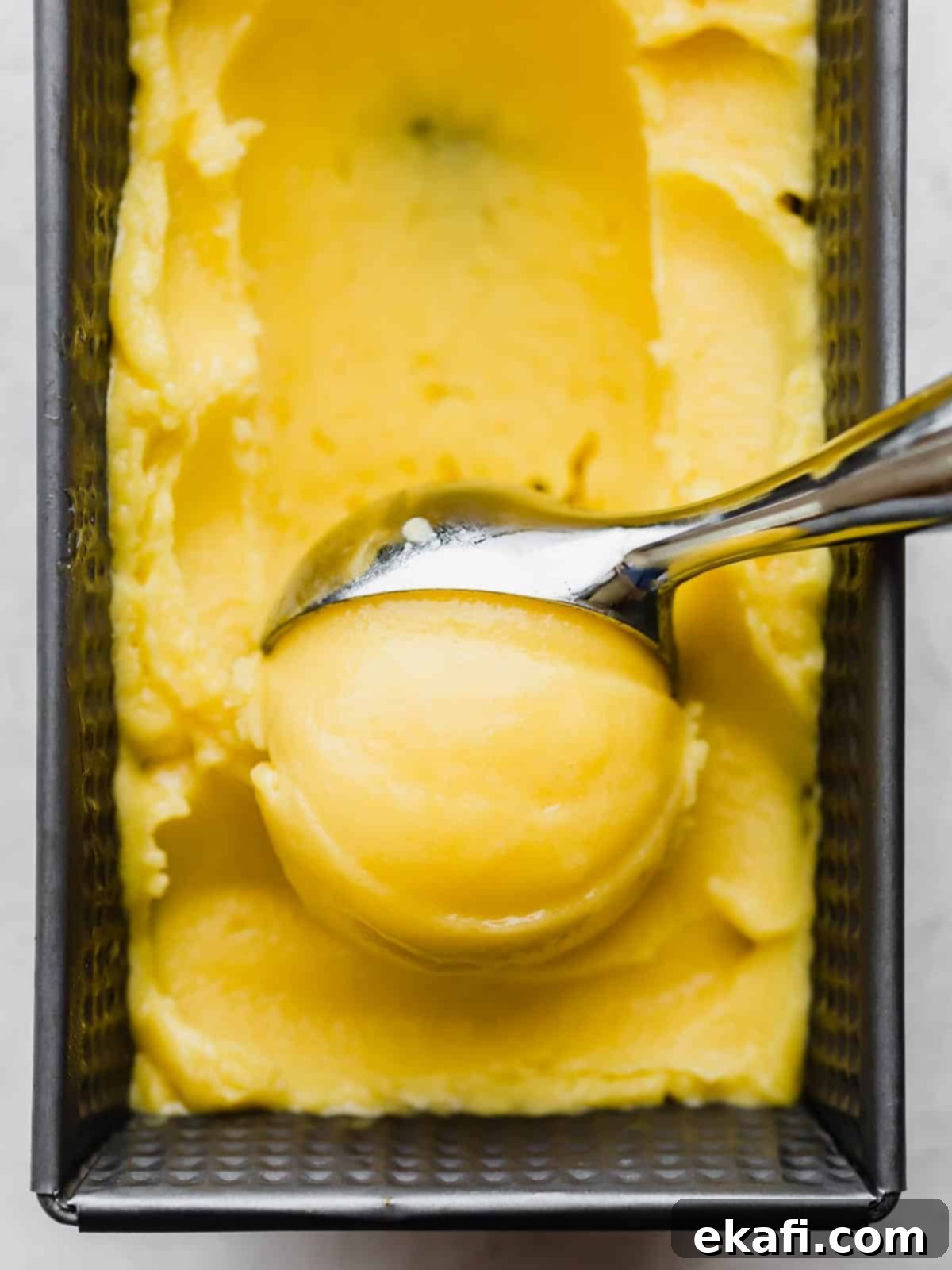Indulge in the Ultimate Creamy Homemade Mango Sorbet: Your Perfect Summer Escape
There’s nothing quite like the refreshing taste of a perfectly crafted sorbet on a warm summer day. This homemade Mango Sorbet recipe delivers an exquisitely soft and creamy texture, making it the ideal cool treat to beat the heat. Forget icy, hard sorbets; by combining the power of your blender and an ice cream machine, we’ll achieve an unbelievably smooth consistency that melts in your mouth, not in five minutes.
For more delicious mango-inspired recipes, be sure to try our mango overnight oats for a healthy and satisfying breakfast.
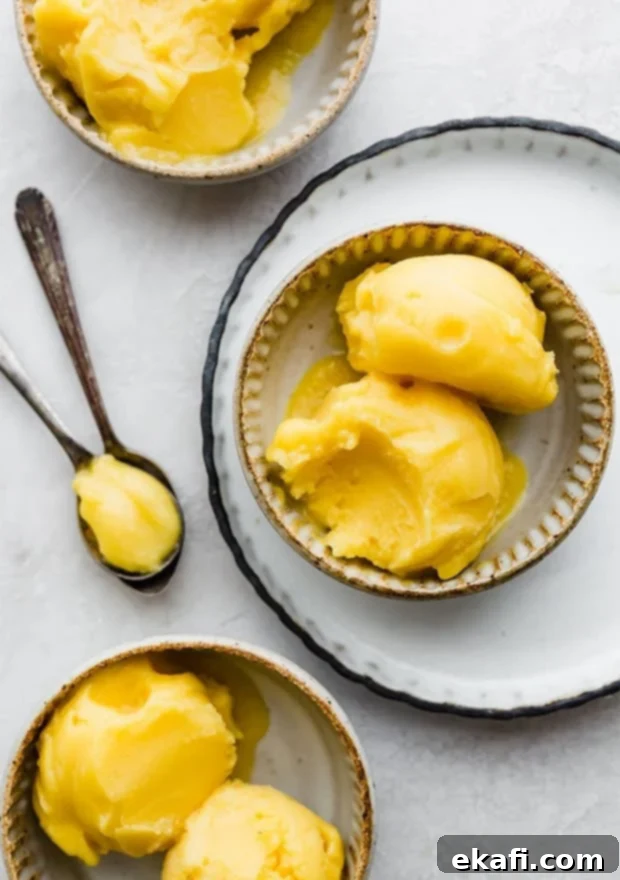
Why This Creamy Mango Sorbet Recipe Is a Game-Changer
This creamy mango sorbet, much like my popular raspberry sorbet recipe, stands out as my absolute favorite summer indulgence. Its light, fresh, and intensely fruity flavor makes it the perfect antidote to sweltering days. But what truly sets this recipe apart is its ingenious approach to texture, ensuring a consistently smooth, non-icy treat every time. We dive into a little bit of food science to achieve this superior result.
The Magic of Corn Syrup: Preventing Icy Sorbet
You might raise an eyebrow at the mention of corn syrup in a homemade recipe, but in the world of frozen desserts, it’s a secret weapon. The inclusion of corn syrup in this mango sorbet recipe plays a crucial role in achieving that coveted soft, scoopable texture. Unlike granulated sugar alone, corn syrup is an invert sugar, meaning it has a unique molecular structure that interferes with the formation of large ice crystals. These large crystals are the culprits behind the grainy, rock-hard sorbets we all dread.
Furthermore, corn syrup helps to lower the freezing point of the mixture, preventing the sorbet from freezing completely solid. This means when you take your delicious mango sorbet out of the freezer, it won’t be an unyielding block. Instead, it will be perfectly soft and ready to scoop, maintaining its structure for longer than typical sorbets without turning into a liquid puddle in your bowl within minutes. It’s not just about texture; corn syrup also enhances the overall flavor, bringing out the vibrant sweetness of the mango without making it overly sugary.
Achieving a Silky Smooth Texture: The Seed Crystal Method
Beyond corn syrup, another sophisticated food science technique contributes to this sorbet’s unparalleled smoothness: the “seed crystal” method. Traditional sorbet making often struggles with the formation of large ice crystals, which result in a coarse, grainy mouthfeel. Our innovative approach bypasses this issue entirely.
Here’s how this clever technique works: A small portion of the mango puree is flash-frozen. This rapid freezing creates a multitude of tiny ice crystals, which we call “seed crystals.” When this frozen puree is later combined with the larger, chilled (but not frozen) portion of the mixture, it initiates a remarkable chain reaction. The existing small “seed crystals” act as templates, encouraging the rest of the mango puree to form equally small, uniform ice crystals. This meticulous control over crystal formation is the key to a consistently smooth and wonderfully creamy sorbet, free from any hint of graininess.
As you can see, a little understanding of food science goes a long way in crafting this truly exceptional mango sorbet. The meticulous combination of corn syrup and the seed crystal method ensures an end result that is quite possibly the creamiest, dreamiest homemade sorbet you’ll ever taste!
Looking for more delightful frozen fruit recipes? Don’t miss our pineapple mango popsicles and kiwi strawberry popsicles for refreshing treats the whole family will love.
Essential Ingredients for Your Perfect Mango Sorbet
Crafting this luscious mango sorbet requires just a few key ingredients, each playing an important role in achieving its signature creamy texture and vibrant flavor. Quality ingredients are the foundation of any great recipe, and this sorbet is no exception.
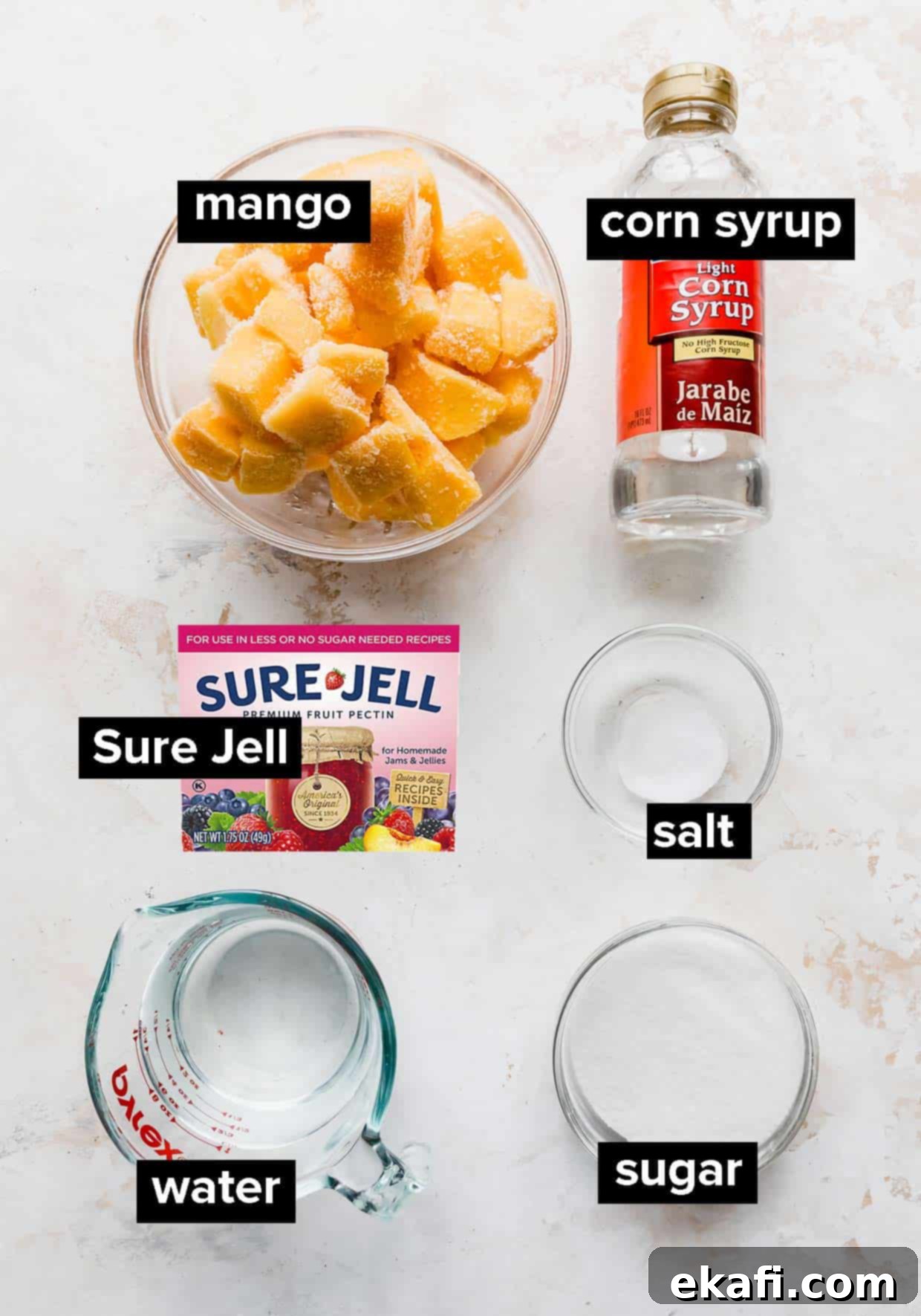
- Mangoes: The star of our show! You can use either fresh or frozen mangoes for this recipe. If using fresh, choose ripe mangoes that yield slightly to gentle pressure and have a fragrant aroma. Make sure you have a total of 20 ounces, which is roughly 3-4 medium-sized mangoes once peeled and pitted, or about 4 cups of chopped frozen mango. Ripe fresh mangoes will naturally lend a sweeter and more intense flavor to your sorbet.
- Corn Syrup: As discussed, corn syrup is indispensable for achieving the perfect soft texture and preventing sugar crystallization, which can lead to an icy sorbet. It also subtly enhances the natural sweetness and flavor of the mango, making every spoonful a delight. Opt for light corn syrup for the best results.
- Sure Jell (Pectin): This is a pectin-based product designed for less or no sugar needed recipes, and it’s a clever addition here. Pectin acts as a stabilizer, giving your homemade sorbet a more robust structure. This means that once frozen, your sorbet will hold its form better and won’t melt as quickly, allowing you more time to savor its creamy goodness.
- Granulated Sugar: Provides additional sweetness to balance the tartness of the mango and contributes to the overall texture by interacting with the corn syrup and pectin.
- Water: To create the base syrup and help achieve the desired consistency when blending.
- Salt: A tiny pinch of salt might seem counterintuitive for a sweet dessert, but it’s a chef’s secret! Salt helps to enhance and brighten all the other flavors, making the mango taste even more vibrant and delicious.
Crafting Your Creamy Mango Sorbet: Step-by-Step Instructions
Follow these detailed steps to create your own irresistible batch of creamy mango sorbet. Precision and patience are key to achieving the perfect texture.
- **Prepare the Pectin Base:** In a small to medium saucepan, combine the specified amount of water, Sure-Jell, and a pinch of salt. Place the saucepan over medium heat, stirring constantly with a whisk. Continue to cook and stir until the Sure-Jell is completely dissolved, which should take approximately 4-5 minutes. Once dissolved, remove the saucepan from the heat and allow the mixture to cool for about 10 minutes. This cooling period is important before adding it to the blender.
- **Blend the Mango Puree:** Add the prepared mango chunks (fresh or frozen), granulated sugar, and light corn syrup into a high-speed blender or a robust food processor. Carefully pour in the cooled Sure-Jell mixture from the saucepan.
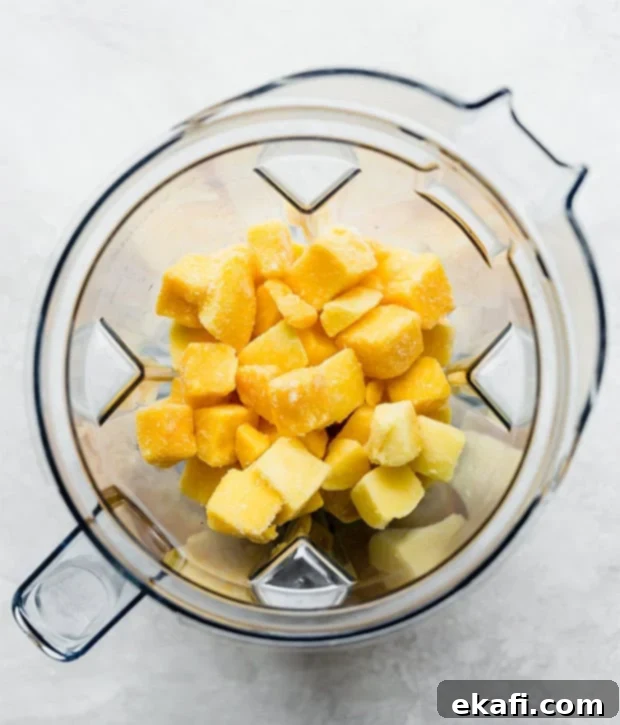
- **Achieve Smoothness:** Secure the lid on your blender and process the ingredients until the mixture is perfectly smooth and lump-free. Depending on your blender’s power, you might need to stop and scrape down the sides a few times to ensure everything is incorporated evenly. The goal is a uniform, silky mango puree.
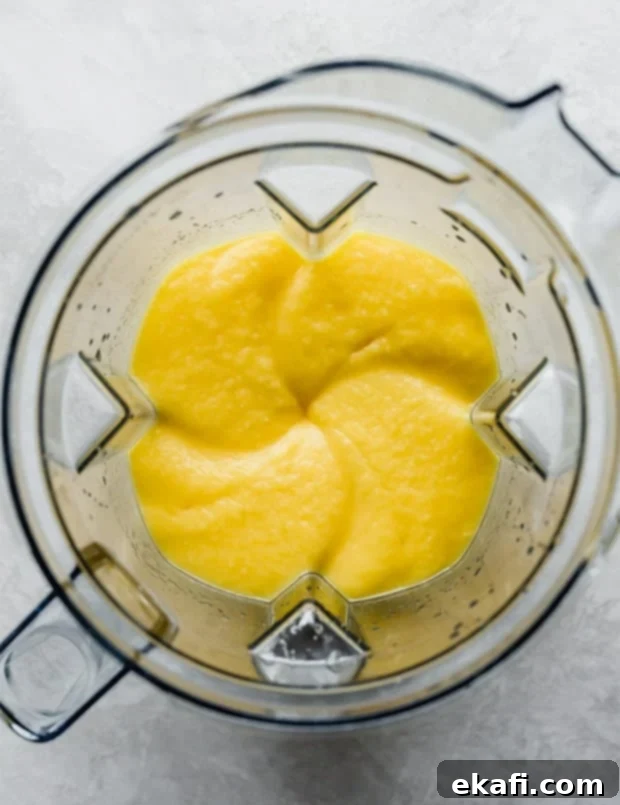
- **Divide the Puree:** Carefully divide the freshly blended mango puree into two separate bowls. Measure out precisely 1 cup of puree into a small bowl. The remaining, larger portion of puree should go into a separate, larger bowl. This division is crucial for the “seed crystal” technique.
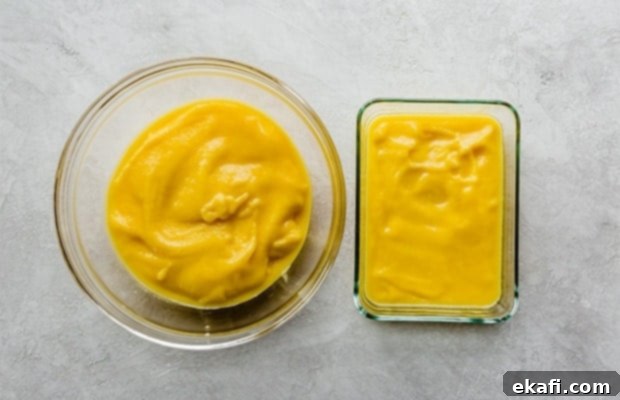
- **Chill and Freeze:** Cover both bowls tightly with plastic wrap to prevent a skin from forming and to lock in freshness. Place the small bowl containing 1 cup of puree into the freezer. This is our “seed crystal” portion. Place the larger bowl with the remaining mango mixture into the refrigerator. Both bowls should chill/freeze for a minimum of 3-4 hours, or ideally until the smaller portion is completely frozen solid.
- **Combine for Churning:** Once the small bowl of puree is frozen solid, remove it from the freezer. Use a sturdy spoon or a fork to scrape the frozen puree into the large bowl containing the chilled (refrigerated) puree. Stir well to combine the frozen “seed crystals” with the liquid base. This immediate mixing helps kickstart the small ice crystal formation.
- **Churn in Ice Cream Machine:** Pour the combined mango mixture into the frozen bowl of your ice cream machine. Churn the mixture according to your manufacturer’s instructions. Typically, this process takes about 15-25 minutes, or until the sorbet reaches a consistency similar to a very thick milkshake or soft-serve ice cream. Be careful not to over-churn, as this can affect the texture.
- **Final Freeze and Serve:** At this stage, your mango sorbet is technically ready to eat for a soft-serve experience. However, for a firmer, more scoopable texture, transfer the churned sorbet to an airtight, freezer-safe container. Cover it with a lid or plastic wrap, pressing the plastic wrap directly onto the surface of the sorbet to prevent ice crystal formation. Freeze for an additional 2-3 hours, or until it reaches your desired firmness. Scoop and enjoy!
Expert Tips for the Best Mango Sorbet
To ensure your homemade mango sorbet turns out perfectly creamy and delicious every time, keep these expert tips in mind:
- Prepare Your Ice Cream Machine Bowl in Advance: Since this recipe relies on an ice cream machine, proper preparation is key. Make sure to freeze your ice cream machine bowl for at least 24 hours prior to making the sorbet. A thoroughly frozen bowl is essential for efficient churning and achieving the ideal smooth, thick consistency. Some machines may require even longer, so always check your manufacturer’s instructions.
- Mango Selection: While both fresh and frozen mangoes work beautifully, opt for ripe, sweet fresh mangoes if possible. Ripe mangoes will have a more intense flavor and natural sweetness, reducing the need for additional sugar and enhancing the overall taste of your sorbet. If using frozen, ensure it’s high-quality frozen mango with no added sugars or preservatives. Always weigh your mangoes to ensure you have the correct 20 oz. quantity.
- Don’t Over-Churn: Churning time is crucial. The sorbet should only churn for approximately 18-25 minutes. Over-churning, even for just 30 minutes, can lead to a “loose” or crumbly texture rather than a smooth and creamy one. Monitor the mixture as it churns, as machine efficiencies can vary. Stop when it resembles a thick milkshake.
- Storage for Longevity: For the best texture and flavor, consume your homemade mango sorbet within 5-7 days. Store it in an airtight, freezer-safe container. To prevent freezer burn and the formation of ice crystals on the surface, press a piece of plastic wrap directly onto the surface of the sorbet before sealing the container.
- Ripening Fresh Mangoes: If your fresh mangoes aren’t quite ripe, you can speed up the process by placing them in a paper bag at room temperature for a day or two. Add an apple or banana to the bag to release ethylene gas, which further accelerates ripening.
Frequently Asked Questions About Mango Sorbet
Sorbet is typically a frozen dessert made from fruit puree or juice, sugar, and water, churned in an ice cream machine to create a light, icy, and refreshing texture. Unlike ice cream, it contains no dairy or eggs.
The primary difference lies in the ingredients. Sorbet is a dairy-free and egg-free frozen dessert, relying solely on fruit, sugar, and water for its base. Ice cream, on the other hand, contains dairy products like milk and cream, and often eggs, which give it a richer, creamier consistency and higher fat content.
Preventing large, icy crystals is key to a smooth sorbet. This recipe employs two main strategies: the use of corn syrup and the “seed crystal” method. Corn syrup, an invert sugar, inhibits large ice crystal formation and helps keep the sorbet softer. The “seed crystal” technique (flash-freezing a small portion of puree) encourages the entire batch to form tiny, uniform ice crystals, resulting in an exceptionally smooth and creamy texture. Sure-Jell (pectin) also helps stabilize the mixture, further reducing ice formation and improving melt resistance.
While corn syrup is highly recommended for its unique anti-crystallization properties, some substitutes exist, such as glucose syrup or Trimoline (inverted cane sugar syrup). These are generally sweeter than corn syrup and have not been tested with this specific recipe. Altering the sugar balance can significantly impact the final texture and freezing point. If you choose to experiment, start with a smaller amount and be prepared for potential variations in consistency.
Yes, Karo syrup is a popular brand of corn syrup, readily available in most grocery stores. For this recipe, I specifically used and recommend light corn syrup over dark corn syrup, as dark corn syrup has a stronger flavor profile that could subtly alter the delicate taste of the mango.
Technically, yes, you can attempt to make sorbet without an ice cream machine by using the “freezing and stirring” method (freezing the mixture in a shallow pan and scraping it every 30-60 minutes). However, an ice cream machine is highly recommended for this recipe. The continuous churning process is what truly develops the incredibly smooth, light, and creamy texture that makes this sorbet so special. Without it, you’ll likely achieve a more icy and less refined consistency.
Any sweet, ripe mango variety will work well. Alphonso, Ataulfo (honey mango), or Kent mangoes are excellent choices known for their rich flavor and low fiber content. Ensure your chosen mangoes are fragrant and slightly soft to the touch for the best taste.
Absolutely! While this recipe focuses on pure mango bliss, you can certainly experiment with adding other complementary fruits. A small amount of pineapple, passion fruit, or a hint of lime zest could add an interesting twist. Just be mindful of the total liquid content and sugar balance, as this might affect the final texture.
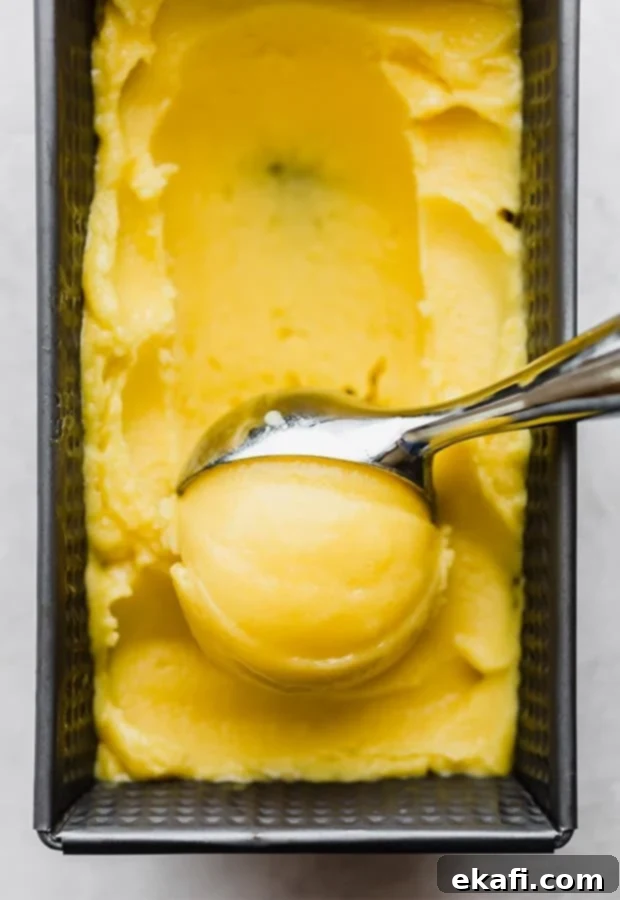
Explore More Frozen Dessert Recipes
If you love this creamy mango sorbet, you’ll definitely want to check out these other delightful frozen treats:
- Easy No-Churn Oreo Ice Cream: A simple yet decadent treat without an ice cream machine.
- Raspberry Ice Cream: Another fruity and refreshing homemade ice cream favorite.
- Classic Homemade Vanilla Ice Cream: The timeless classic, perfected in your own kitchen.
- Easy Raspberry Sauce: A versatile and vibrant topping that’s absolutely perfect for any ice cream or sorbet!
Did you try this incredible mango sorbet recipe? We’d love to hear your thoughts! Click here to leave a rating and review, and share your experience with our community.
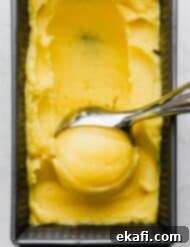
Print
SaveSaved!
Review
Creamy Homemade Mango Sorbet
Ingredients
- 1 cup water
- 1 teaspoon Sure-Jell for Less or No Sugar Needed Recipes
- pinch salt
- 4 cups frozen or fresh mango chunks – approximately 20 ounces. Ensure fresh mangoes are ripe for best flavor.
- 1/2 cup + 2 Tablespoons granulated sugar
- 1/4 cup light corn syrup
Equipment
-
ice cream maker
-
Vitamix/high-speed blender
-
Saucepan
-
Two mixing bowls (one small, one large)
-
Plastic wrap
Instructions
-
Prepare Pectin Syrup: In a medium saucepan, add 1 cup of water, 1 teaspoon of Sure-Jell, and a pinch of salt. Cook this mixture over medium heat, stirring constantly with a whisk, until the Sure-Jell is completely dissolved. This should take about 4-5 minutes. Remove the saucepan from the heat and let it cool for 10 minutes.
-
Blend Ingredients: Transfer the 4 cups of mango chunks (fresh or frozen), 1/2 cup + 2 tablespoons granulated sugar, and 1/4 cup light corn syrup to a high-speed blender or food processor. Pour in the cooled Sure-Jell mixture. Blend until the mixture is completely smooth and creamy, scraping down the sides as needed to ensure no chunks remain.
-
Divide and Chill/Freeze: Divide the smooth mango puree into two separate bowls. Place exactly 1 cup of puree into a small bowl (this will be your “seed crystal” portion). Pour the remaining mango puree into a larger bowl. Cover both bowls tightly with plastic wrap to prevent air exposure. Place the small bowl of puree in the freezer and the large bowl of puree in the refrigerator for 3-4 hours. The small portion should be frozen solid, and the large portion thoroughly chilled.
-
Combine for Churning: Once the chilling/freezing period is complete, remove both bowls from the fridge and freezer. Using a sturdy spoon or fork, scrape the frozen 1 cup portion of mango puree into the larger bowl containing the chilled liquid puree. Stir well to integrate the frozen crystals.
-
Churn in Ice Cream Maker: Pour the entire mango mixture into the frozen bowl of your ice cream machine. Churn for 18-25 minutes, or until the sorbet reaches the consistency of a thick milkshake or soft-serve ice cream. Consult your ice cream machine’s manufacturer instructions for specific guidelines, and avoid over-churning.
-
Final Freeze and Serve: Transfer the freshly churned sorbet to an airtight, freezer-safe container. Press a layer of plastic wrap directly onto the surface of the sorbet before sealing the container with a lid. Freeze for an additional 2-3 hours, or until the sorbet is firm enough for scooping. Remove from the freezer, scoop, and serve immediately for an exquisitely creamy and refreshing treat!
Notes
While it’s technically possible to make sorbet without an ice cream machine by repeatedly stirring and freezing, using a machine is highly recommended for achieving the signature smooth, light, and perfectly creamy texture this recipe aims for.
Avoid over-churning the sorbet. Churning for too long can result in a less desirable, often crumbly or overly soft texture. Aim for 18-25 minutes, or until it reaches a thick milkshake consistency. Keep an eye on your machine, as timings can vary.
Mango choices: You can use either fresh or frozen mangoes, just ensure the total weight is 20 ounces. If using fresh, selecting perfectly ripe mangoes will impart a significantly sweeter and more intense mango flavor to your sorbet, enhancing the overall experience.
Storage: Homemade sorbet is best enjoyed within 5-7 days when stored in an airtight, freezer-safe container. Press plastic wrap directly onto the surface of the sorbet before sealing to prevent ice crystal formation and freezer burn.
